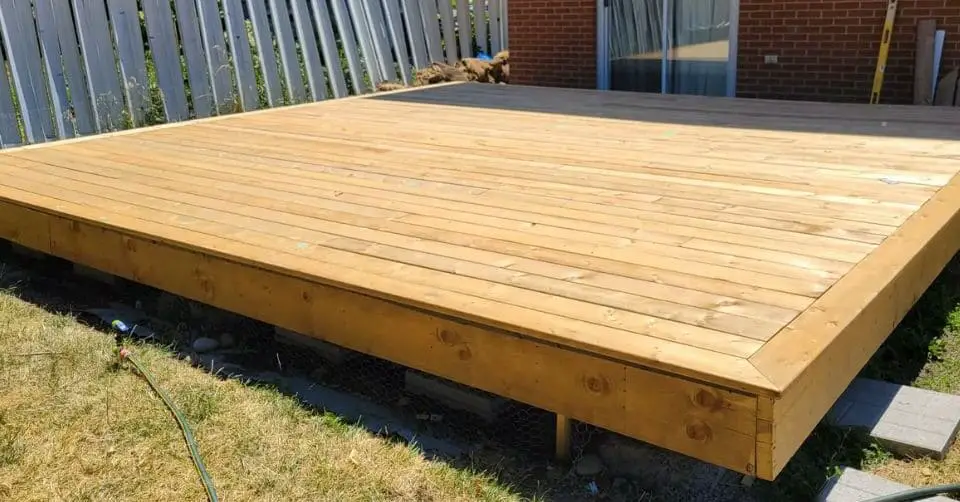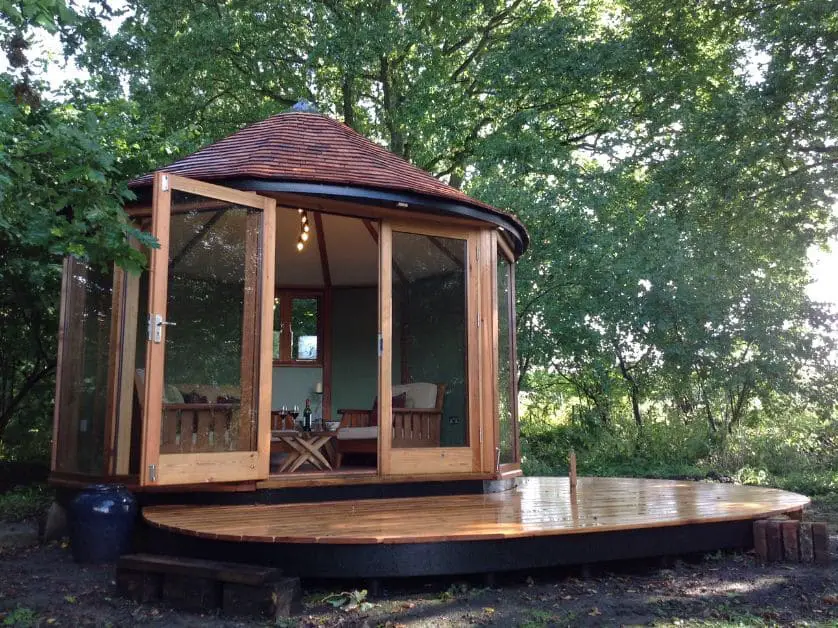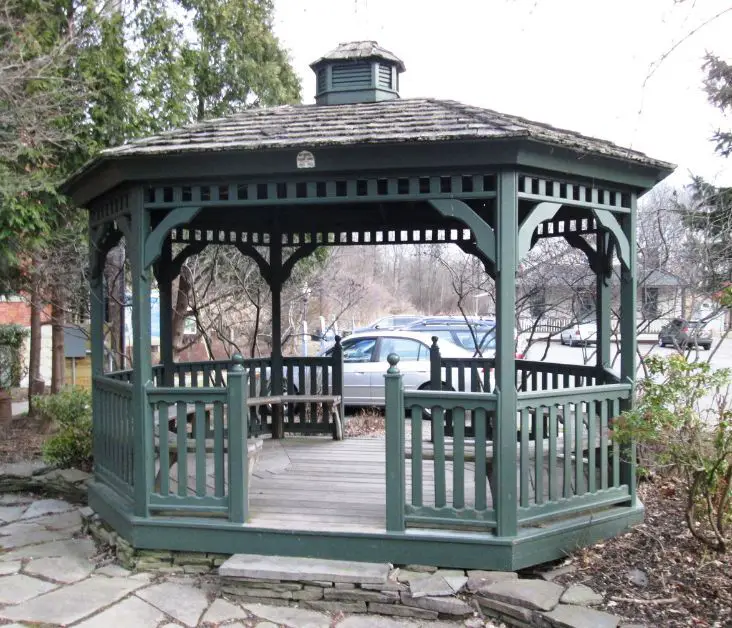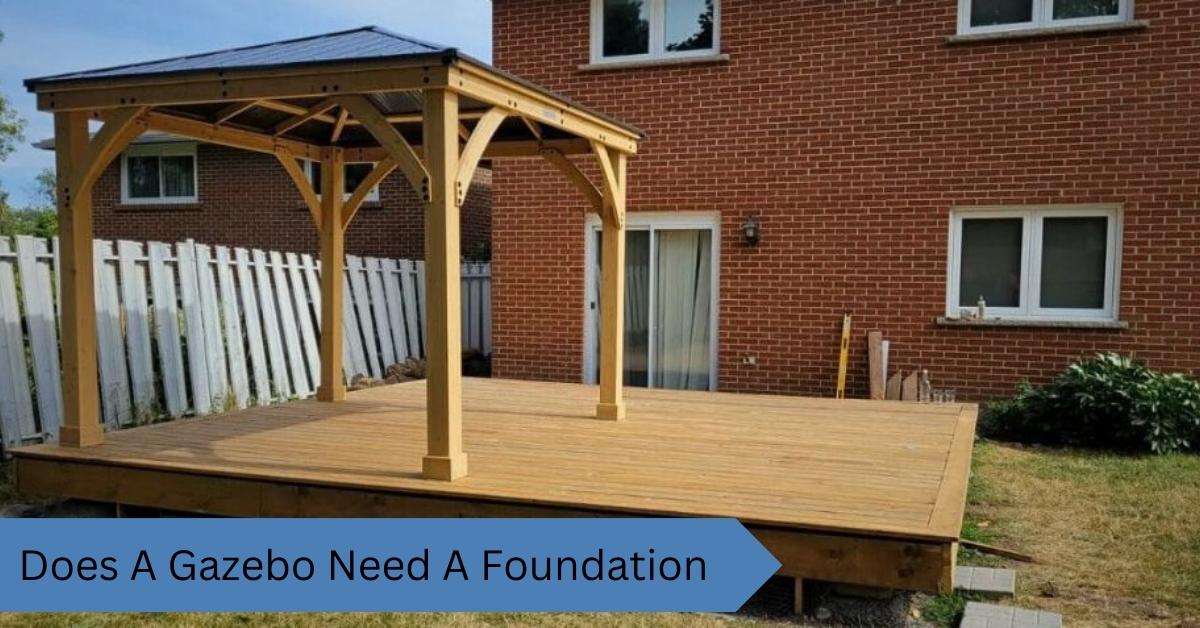A gazebo is a popular outdoor structure that can be used for various purposes, such as relaxation, entertainment, and outdoor dining. When planning to build a gazebo, the foundation is one of the most important considerations.
A foundation provides a stable and secure base for the structure, ensuring it remains level and safe for years to come.
However, the question of whether a gazebo needs a foundation is a common one. While some types of gazebos, such as portable or temporary ones, may not require a foundation, most permanent gazebos will need one to prevent shifting or sinking into the ground over time.
A well-designed foundation also ensures proper drainage and prevents water damage, which can compromise the structure’s stability.
This article. We will explore the factors determining whether a gazebo needs a foundation, the different types that can be used, and the benefits of having a solid and sturdy foundation for your gazebo.
Does a gazebo need a foundation: To secure a gazebo from wind, use strong anchors or stakes firmly attached to the ground. Reinforce with guy lines and tensioners for added stability. Regularly inspect and maintain all components to ensure proper wind resistance.
Does a gazebo need a foundation: Easy Guide

Whether or not a gazebo needs a foundation depends on several factors, such as the size of the gazebo, local building codes, and ground conditions.
A foundation can stabilize and prevent the gazebo from sinking or shifting over time, especially for larger and heavier gazebos.
It can also offer protection from the elements, increase durability, and provide more customization options.
Ultimately, it is up to the homeowner to determine if a foundation is necessary for their particular gazebo, but considering these factors can help make an informed decision.
Definition of a gazebo

A gazebo is a type of outdoor structure that is typically round, octagonal, or rectangular in shape and is supported by pillars or posts.
It has a roof that is often made of wood, shingles, or metal and may have a decorative finial or dome at the top.
Gazebos can be made from various materials, including wood, vinyl, or metal, and can be designed to complement the style of a particular landscape or architecture.
Types of gazebos
Here are some common types of gazebos:
Traditional Gazebos:

Traditional gazebos are typically made of wood and have a classic, ornate design.
They often feature intricate carvings, moldings, and decorative elements like lattice screens or trellises.
Modern Gazebos:

Modern gazebos have a sleek, contemporary design that emphasizes simplicity and functionality.
They are often made of metal or vinyl, with clean lines and minimal ornamentation.
Portable Gazebos:

Portable gazebos are lightweight and easy to assemble and disassemble, making them ideal for temporary events, such as outdoor parties or weddings.
They are typically made of lightweight materials, such as fabric or mesh, and can be easily transported from one location to another.
Pergolas:
Pergolas are similar to gazebos but have an open roof supported by a series of beams or posts.
They provide shade and support for climbing plants, such as vines or roses, and are often used to create a romantic or intimate setting in a garden or backyard.
Uses of gazebos
Gazebos are outdoor structures that can be used for a variety of purposes. Here are some common uses of gazebos:
Outdoor Dining:
Gazebos are often used for outdoor dining, providing a shaded area for people to gather and enjoy a meal in the fresh air. Some gazebos have built-in benches or tables, while others can be customized to accommodate a full dining set.
Entertainment Space:
Gazebos can also serve as an entertainment space, providing a covered area for outdoor gatherings, such as parties or barbecues. They can have various amenities, such as lighting, sound systems, and even televisions or projectors.
Relaxation and Meditation:
Gazebos can also provide a peaceful retreat for relaxation and meditation. Some gazebos are designed with features such as built-in benches or hammocks and can be used as a quiet space for reading, yoga, or simply enjoying the natural surroundings.
Garden Focal Point:
Finally, gazebos can be used as a garden focal point, adding a touch of beauty and elegance to any outdoor space. They can be positioned to frame a view or highlight a particularly beautiful garden feature, such as a water fountain or statue.
Definition of a Foundation

A foundation is an essential component of any structure, providing the base on which the entire building rests.
It is part of a building that transfers the weight of the structure and its contents to the underlying soil or rock.
A foundation is a support system that distributes a building load evenly over the ground, preventing the structure from sinking or shifting over time.
Types of Foundations
Several types of foundations can be used for buildings, each with its own advantages and disadvantages. Some of the most common types of foundations include:
Strip Foundation
A strip foundation, also known as a shallow foundation, is a type of foundation that is used for small to medium-sized structures.
It involves excavating a trench along the perimeter of the building and pouring concrete into the trench to form a continuous strip. The foundation is then reinforced with steel bars to provide additional strength.
Pad Foundation

A pad foundation is similar to a strip foundation but is used for individual columns or posts rather than the entire perimeter of the building.
It involves creating a square or rectangular pad of concrete at the base of each column, which spreads the load of the column evenly over the ground.
Raft Foundation
A raft foundation, also known as a mat foundation, is a type of foundation that is used for larger structures or where the ground is particularly soft or unstable. It involves pouring a large slab of concrete over the entire building area, which spreads the load over a wider area and provides additional stability.
Piled Foundation
A piled foundation is a type of deep foundation used where the soil is particularly weak or unstable. It involves drilling deep holes into the ground and inserting long, reinforced concrete or steel piles into the holes. The piles are then anchored to the structure, providing a secure base for the building.
Importance of a Foundation for a Structure
The foundation is one of the most important components of any building, as it provides the support and stability needed to ensure the structure remains safe and secure. A properly designed and constructed foundation can help prevent a wide range of issues, including:
Settlement
If a foundation is not properly designed or constructed, it can lead to settlement, which occurs when the foundation sinks or shifts over time. Settlement can cause the building to become unstable, leading to cracking, uneven floors, and other structural problems.
Moisture Damage
A foundation that is not designed correctly or constructed can also lead to moisture damage, which can compromise the structural integrity of the building. Water can seep into the foundation, leading to rot, mold, and other damage that can weaken the foundation over time.
Structural Failure
If a foundation is not properly designed or constructed, it can lead to structural failure, which can have serious consequences. In extreme cases, a poorly constructed foundation can lead to the collapse of the building, causing injury or even death.
Does a Gazebo Need a Foundation?
A gazebo is a beautiful and functional addition to any outdoor space. However, before installing a gazebo, it is essential to determine whether it needs a foundation. A foundation can stabilize and prevent the gazebo from sinking or shifting over time.
we will explore the factors to consider, why a foundation is necessary, and the benefits of having a foundation for a gazebo.
Factors to consider
If you’re considering purchasing a gazebo, there are a number of factors to consider. Here are some of the most important ones:
Size of the gazebo:

The size of the gazebo is a crucial factor to consider when deciding whether a foundation is necessary or not.
A small, lightweight gazebo may not require a foundation, while a larger, heavier gazebo may need a more substantial foundation to provide stability.
Local building codes:
Building codes vary from state to state and city to city. Before installing a gazebo, it is essential to check the local building codes to determine whether a foundation is required.
Ground conditions:
The condition of the ground where the gazebo will be installed is another crucial factor to consider. If the ground is uneven or prone to flooding, a foundation may be necessary to prevent the gazebo from sinking or shifting over time.
Reasons why a foundation is necessary
A foundation is a crucial part of any building or structure, including gazebos. Here are some of the main reasons why a foundation is necessary:
Stability:

A foundation provides stability for the gazebo, preventing it from shifting or sinking over time.
This is especially important if the gazebo will be used for activities such as dining or entertaining, where stability is essential.
Protection from the elements
A foundation can protect from the elements, such as rain or snow, by elevating the pavilion off the ground. This can help to prevent water damage and prolong the lifespan of the pavilion.
Durability
A foundation can help to increase the durability of the gazebo by providing a solid base for it to rest on. This can help to prevent damage from wind or other environmental factors that can cause the pavilion to shift or become unstable.
Aesthetics
A foundation can also enhance the aesthetics of the gazebo by providing a solid base on it to rest.
This can help create a more polished and professional look, which can be especially important if the gazebo is used for a special event or occasion.
Benefits of having a foundation for a gazebo
There are several benefits to having a foundation for a gazebo:
Longevity:
By providing stability and protection from the elements, a foundation can help to prolong the lifespan of the gazebo.
This can save homeowners money in the long run by reducing the need for repairs or replacements.
Increased property value:
A well-built foundation can also increase the value of a property, especially if the gazebo is considered a permanent structure.
This can be especially important if the homeowner plans to sell the property in the future.
Safety:
A foundation can also help to ensure the safety of those using the gazebo by preventing it from shifting or becoming unstable.
This is especially important if the gazebo is used for dining or entertaining activities, where safety is a concern.
Customization:
A foundation can also provide more customization options for the gazebo, such as the ability to add electrical or plumbing features.
This can help to make the gazebo more functional and versatile, increasing its overall value to the homeowner.
Types of Foundations for Gazebos
A gazebo is a popular outdoor structure that provides a great space for entertaining, relaxing, and enjoying the outdoors. However, to ensure that your gazebo is stable and long-lasting, it’s important to choose the right foundation.
There are several types of foundations for gazebos, each with its own advantages and disadvantages. In this article, we’ll explore the four main types of foundations for gazebos: concrete, deck platform, pier, and gravel.
Concrete foundation:
A concrete foundation is one of the most popular types of foundation for gazebos. It is a durable and sturdy option that provides a solid base for the structure.
The concrete foundation is poured into a hole dug into the ground and reinforced with rebar or wire mesh for added strength. The hole should be at least 12 inches deep and 12 inches wider than the diameter of the gazebo’s posts.
One of the advantages of a concrete foundation is that it can support heavy structures and withstand harsh weather conditions. It is also a great option for gazebos with permanent structures, such as electrical wiring, plumbing, or other utilities.
However, installing a concrete foundation can be costly and time-consuming, requiring professional help and specialized equipment.
Deck platform foundation:

A deck platform foundation is another popular option for gazebos. It involves building a wooden deck platform that serves as a base for the gazebo.
The deck platform is constructed on top of footings, which are usually made of concrete or steel. The footings are sunk into the ground, providing a stable base for the deck platform.
One of the advantages of a deck platform foundation is that it is relatively easy to install and can be done by a DIYer. It also provides a level surface for the pavilion, making it easier to decorate and furnish.
However, a deck platform foundation can be more expensive than other options, especially if you opt for high-end materials like composite decking. It can also require regular maintenance to ensure that it remains in good condition.
Pier foundation:
A pier foundation is a cost-effective and easy-to-install option for gazebos. It involves digging holes into the ground and pouring concrete into them to create piers.
The piers serve as a base for the pavilion and are topped with steel brackets that support the structure.
One of the advantages of a pier foundation is that it is relatively inexpensive and can be installed quickly.
It is also a great option for gazebos in areas with high water tables or soil with poor drainage. However, a pier foundation may not be suitable for heavy structures or gazebos that require permanent utilities.
Gravel Foundation:
A gravel foundation is a simple and inexpensive option for gazebos. It involves creating a level surface using a layer of gravel and compacting it to create a stable base. The gazebo’s posts are then anchored to the gravel using metal stakes or brackets.
One of the advantages of a gravel foundation is that it is easy to install and can be done by a DIYer. It is also a great option for temporary gazebos or those only used seasonally.
However, a gravel foundation may not be suitable for heavy structures or gazebos that require permanent utilities. It can also be less stable than other options, especially in areas with high winds or heavy rain.
FAQs
Q.1 Do all gazebos require a foundation?
No, not all gazebos require a foundation. It depends on the size of the gazebo, local building codes, and ground conditions.
Q.2 What happens if a gazebo is installed without a foundation?
Without foundation, a gazebo may sink or shift over time, especially if it is large and heavy. This can cause safety issues and potentially costly repairs.
Q.3 What types of foundations can be used for a gazebo?
Several foundations can be used for a gazebo, including concrete slabs, pier and beams, and gravel.
Q.4 Do local building codes require a foundation for gazebos?
Building codes vary by location, so it is essential to check with the local authorities to determine if a foundation is required for gazebos in your area.
Q.5 Can a gazebo be installed on a deck or patio without foundation?
A foundation may not be necessary if the deck or patio is structurally sound and meets local building codes. However, it is still essential to consider the weight of the pavilion and the ground conditions.
Q.6 How much does it cost to install a foundation for a gazebo?
The cost of installing a foundation for a gazebo varies depending on the type of foundation, the size of the gazebo, and local labor costs. Getting a quote from a professional contractor for an accurate estimate is recommended.
Q.7 How long does it take to install a foundation for a gazebo?
The installation time for a foundation depends on the type of foundation and the size of the gazebo. A simple concrete slab foundation can take a few days to install, while a pier and beam foundation may take several weeks.
It is essential to plan and allow sufficient time for the foundation installation before the gazebo is installed.
Conclusion
In conclusion, whether or not a gazebo needs a foundation depends on several factors. Gazebos come in different types, including traditional, modern, portable, and pergolas, and are used for various purposes, such as outdoor dining, entertainment, relaxation, and as a garden focal point.
On the other hand, foundations provide stability, protection from elements, and durability to a structure.
Factors to consider when deciding whether a gazebo needs a foundation include the size of the gazebo, local building codes, and ground conditions.
Local building codes may require a foundation for safety reasons. Ground conditions, such as the slope of the terrain, also play a role in the necessity of a foundation.
The benefits of having a foundation for a gazebo include increased stability, protection from moisture damage, increased durability, and enhanced aesthetics.
A foundation also increases the longevity of the gazebo, improves property value, and allows for customization options.
Different types of foundations for gazebos include concrete, deck platform, pier, and gravel foundations.
Each type of foundation has its advantages and disadvantages, and the choice depends on the specific needs and conditions of the site.
In summary, while a gazebo may not necessarily need a foundation, it is recommended to have one for stability, protection, durability, and aesthetics.
The type of foundation to use depends on factors such as local building codes, ground conditions, and personal preferences.
We hope this guide has helped you understand whether a gazebo needs a foundation. If you have any questions, please ask in the comments section.

